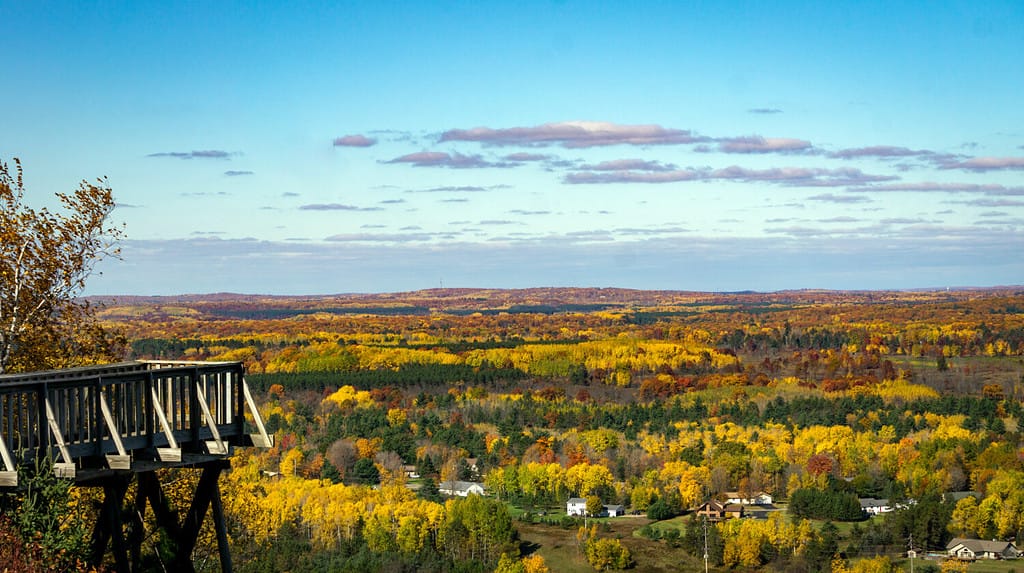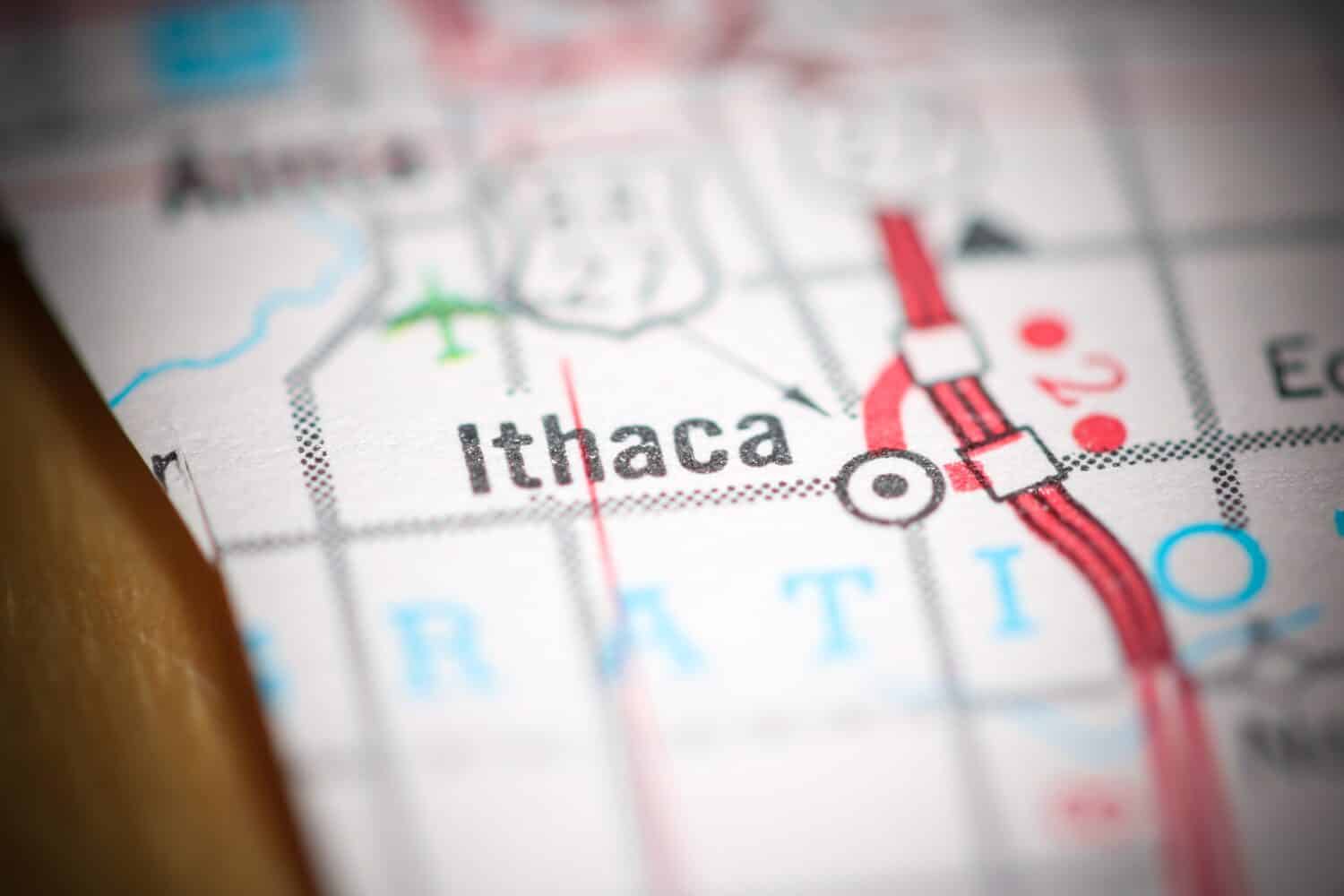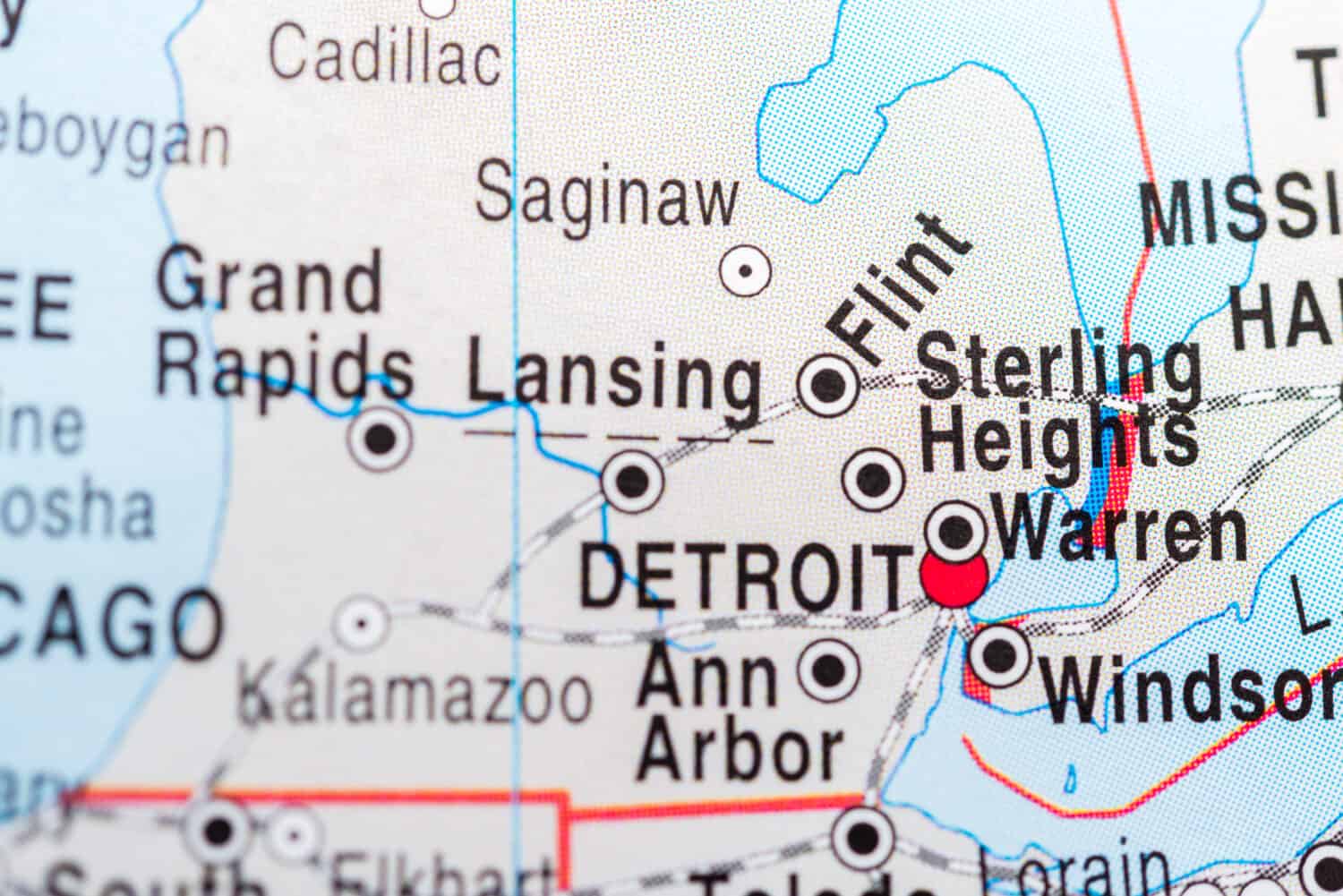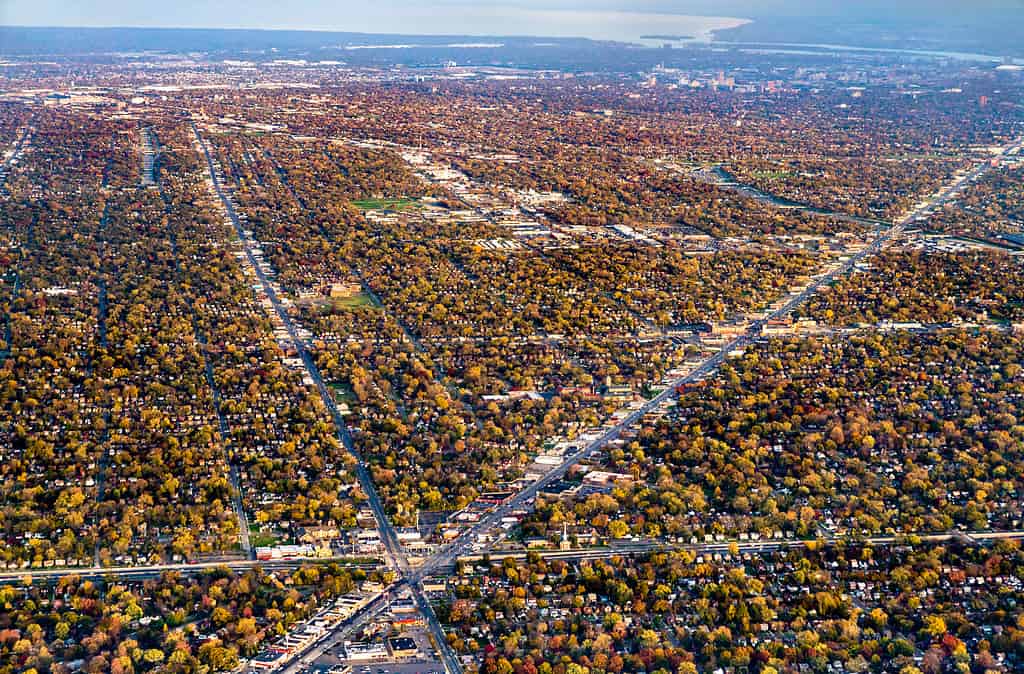
The Great Lake State’s population decline is reaching a point of crisis.
©Amanda Oldham/Shutterstock.com
Michigan has a population of nearly 10.12 million residents, making it the 10th-largest state by population. The United States Census Bureau projected annual declines beginning in 2045 in the Great Lake State. If the state continues to see stagnant growth, it will result in broader implications for the economy through a shrinking workforce, diminishing customer base, and tax revenues. In fact, only one other state, West Virginia, fared worse than Michigan in population decline. Since 1990, the state has only grown 8.4%, ranking 49th in the country. So, what counties in Michigan are facing population decline?
The Census recorded 17 cities that had a net loss of over 1,000 residents. These included Detroit, Ann Arbor, Warren, Dearborn, Grand Rapids, Sterling Heights, Livonia, and Flint. The crisis lies in the fact that these losses just keep coming! In fact, Michigan’s second-biggest city, Grand Rapids, lost an estimated 843 people one year after losing 947 people. However, just because a city’s population declined does not mean the county is in trouble.
Don’t feel too bad for the Mitten State; all hope isn’t lost! The state’s college towns were the big gainers after students returned in 2022, following the pandemic. These towns include East Lansing, Ann Arbor, Marquette, Ypsilanti, and Allendale Township in Ottawa County.
Let’s take a look at the plummeting populations of these Michigan counties!
Top 10 Biggest States by Population
| State | Population |
|---|---|
| California | 38,915,693 |
| Texas | 30,500,280 |
| Florida | 22,661,577 |
| New York | 19,496,810 |
| Pennsylvania | 12,931,957 |
| Illinois | 12,477,595 |
| Ohio | 11,747,774 |
| Georgia | 11,037,723 |
| North Carolina | 10,832,061 |
| Michigan | 10,030,722 |
1. Wayne County

The 2020 census showed population loss in Detroit slowing, but the city continues to shed residents.
©Sean Pavone/Shutterstock.com
Wayne County is the most populous county in Michigan, but also one that is facing population decline. According to the U.S. Census Bureau, the county’s population is 1,793,561. This makes it the 19th most populous county in the United States. And even though it is the state’s largest county, the most people left Wayne County than any other county in Michigan between 2020 and 2022. The drop of 16,030 people in the short period makes it the seventh-worst drop of any county in the nation. Wayne County lost around 36,506 residents between 2020 and 2022, an -1.8% drop.
The county is also home to Detroit, the largest city in the state. The city lost nearly 1% of its population equating to around 7,791 residents falling to the 29th city in the nation. It contains fewer residents than Memphis or Louisville. Wayne County’s decline can be attributed to crime. In fact, in Detroit, the crime rate is higher than 99.9% of other cities, according to city-data.com.
Top 20 Most Populous Counties In the United States
| County | State | Population |
|---|---|---|
| Los Angeles | California | 9,721,138 |
| Cook | Illinois | 5,109,292 |
| Harris | Texas | 4,780,913 |
| Maricopa | Arizona | 4,551,524 |
| San Diego | California | 3,276,208 |
| Orange | California | 3,151,184 |
| Miami-Dade | Florida | 2,673,837 |
| Dallas | Texas | 2,600,840 |
| Kings | New York | 2,590,516 |
| Riverside | California | 2,473,902 |
| Clark | Nevada | 2,322,985 |
| Queens | New York | 2,278,029 |
| King | Washington | 2,266,789 |
| San Bernardino | California | 2,193,656 |
| Tarrant | Texas | 2,154,595 |
| Bexar | Texas | 2,059,530 |
| Broward | Florida | 1,947,026 |
| Santa Clara | California | 1,870,945 |
| Wayne | Michigan | 1,793,561 |
| Alameda | California | 1,628,997 |
2. Washtenaw County

The town of Ann Arbor gained residents due to students returning after COVID-19 precautions.
©Better Planet Media/iStock via Getty Images
Washtenaw County saw a 1.6% drop in residents since 2020. With a population of 366,376, it is Michigan’s sixth-largest county but continues to see a population decline as residents look outside city life.
For example, Ann Arbor Township led the county in growth over those two years, with an estimated 5% jump in population. However, its more urban neighbor, the city of Ann Arbor, dropped an estimated 3%, or some 4,000 residents.
People seem to be leaving for other counties and states due to retirement, wanting to be closer to family, and lifestyle changes influenced by the pandemic along with housing prices in cities that don’t warrant the money.
Top 10 Most Populous Counties In Michigan
| County | Population |
|---|---|
| Wayne County | 1,757,043 |
| Oakland County | 1,269,431 |
| Macomb County | 874,195 |
| Kent County | 659,083 |
| Genesee County | 401,983 |
| Washtenaw County | 366,376 |
| Ottawa County | 300,873 |
| Ingham County | 284,108 |
| Kalamazoo County | 261,173 |
| Livingston County | 196,161 |
3. Gratiot County

A large influx of vacation rentals and part-time residents causes population declines.
©SevenMaps/Shutterstock.com
Gratiot County is reported to be shrinking by an average of 0.2% per year since 2010. It is the state’s 39th-largest county. In 2010, its population was 42,476, and it now has an estimated population of 41,545.
The county seat in Gratiot is Ithaca whose population is currently declining at a rate of -.32% annually. The city’s population decreased by .94% according to the last Census with a recorded population of 2,863. It seems that the county’s natural decline is playing a part in the population numbers as well as residents leaving for other opportunities. Births are plummeting and deaths are rising. Michigan as a whole is seeing residents leave for other Midwest states like Ohio which is growing faster.
4. Macomb County

Warren is a city in Macomb County that borders Detroit to the north.
©Tudoran Andrei/Shutterstock.com
The tri-county area consisting of Wayne, Oakland, and Macomb all lost population. Macomb County was one of the multiple counties that lost over 1,000 people from 2021 to 2022. The county’s current population sits at 874,195 which is an -0.8% decrease.
The eastern county borders Lake St. Clair, and is part of northern Metro Detroit, so it is no surprise that the county’s population declined. The US Census Bureau stated Detroit’s declined by nearly 8,000 over the last couple of years. The impact of Detroit’s crime rate and lack of housing affects surrounding counties. Residents are also moving down South for more affordable homes in better neighborhoods, lower taxes, warmer weather, and the new flexibility of remote work.
5. Oakland County

The counties of the Detroit metropolitan area have the largest population decline.
©Leonid Andronov/ via Getty Images
Oakland County is another principal county of the Detroit metropolitan area that contains the bulk of the city’s northern suburbs. It is the second-most populous county in the state behind Wayne County and the largest in the United States without a city of 100,000 residents. Also, in 2010, it was among the 10 wealthiest counties in the United States to have over one million residents. Today, the county has 1,269,431 residents, a 0.4% decrease. In the last two years, the county saw a population decline. According to the Census, the population of 1,269,431 is almost 5,000 less than the 2020 Census count.
In 2022, the county saw an increase in births, but deaths also increased which resulted in a second year of natural population decrease. Once again, domestic migration was the most important component of population change for Oakland County. Other counties, and the state as a whole, saw the painful trend of young people leaving for education and jobs, and older residents retiring to other states, especially the South.
6. St. Clair County

City officials in St. Clair County believe the need for more housing is a huge factor for population decline.
©Paul Massie Photography/iStock via Getty Images
Though St. Clair County isn’t necessarily the biggest or busiest county in Michigan with a population of 160,151, it still saw a 0.1% decrease in its population. The 13th-most populated county borders the west bank of the St. Clair River, and its county seat, Port Huron, sits at the north end of the county on Lake Huron.
The rural county and riverside towns experience population decline due to declining employment in agriculture and extractive industries such as mining and oil. Rural areas also lose residents due to natural decreases where the number of deaths is higher than the number of births. However, towns can sustain themselves because natural decrease can get offset by residents moving to rural areas for a quieter way of life.
Conclusion
Michigan is finding it hard to keep people in the state. The harsh winters, declining employment, and rising housing market in bleak landscapes can’t compare to the sunshine, beaches, and views of the southern states.
Even its football rival, Ohio, is growing faster than the Wolverine State. As are other Midwest states such as Indiana, Illinois, and Wisconsin. This means Michiganders can’t blame the weather entirely because those states have similar temperatures. So, why do so many residents leave the state? And why are counties in Michigan experiencing population decline?

Detroit sued the Census Bureau in 2022. The city accused the agency of undercounting its population.
©f11photo/Shutterstock.com
The answers are simple. Births are not overtaking deaths. Families are becoming smaller due to the cost of living. Also, fewer residents in a county mean fewer workers in a county. This leads to labor shortages. Fewer workers snowball into diminished tax revenue, which leads to less money to fix crumbling infrastructure. Michigan’s politicians and city officials are desperately trying to make the Great Lakes State more attractive to people because population decline costs states their voice in Congress. The Census helps set political district boundaries at the state and congressional level. It also helps determine federal funding levels. Fewer people means less money. State leaders continue to find ways to reverse the population decline and bring residents to the Great Lakes State.
Thank you for reading! Have some feedback for us? Contact the AZ Animals editorial team.








